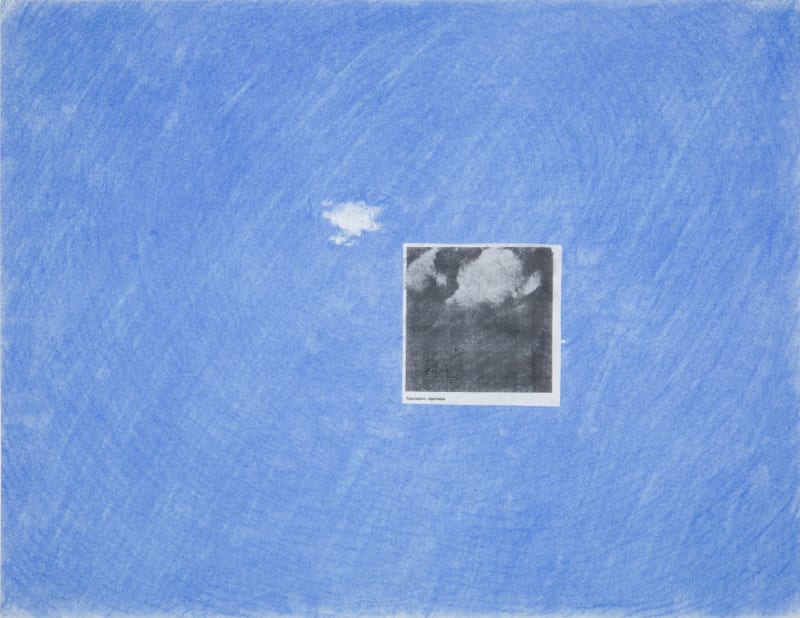In Massinissa Selmani’s understated aesthetic, complex ideas are carried by the barest of means and always with a light touch. A section of a miniature barrier embedded in a rock, a few cursory lines in chalk denoting a cloud, the outline of a man bearing a blank flag, a portion of a monumental sculpture held aloft by a fluttering bird: whether in sculptures, drawings or animated films, the significance of these motifs hangs suspended. An atmosphere of quiet ambiguity is characteristic of his practice. The small scale of the sculptures, which could easily be imagined much larger, is exactly judged for their effect as thoughts made manifest in material form. The finely measured pencil-drawn images float on an empty expanse of white paper, usually with no hint of a setting in a particular location; they exist outside of historical time and geographical space - yet those constraining conditions of human life are precisely their subject.
In his new exhibition at the Selma Feriani Gallery in London’s Cromwell Place, a second chapter of one shown in Sidi Bou Said, in Tunisia, in 2022, Selmani meditates on interrelated themes of control and exclusion, territorial borders and crossings, closeness and distance, flight and freedom. The exhibition’s title, ‘On a rock, a brief circle of sun’, conveys the elemental basis of his project, in which shadows play a defining role. Ephemeral and immaterial in themselves, they give substance to depicted phenomena and mark the passage of time. In drawings where spare delineation is the means of representing people and things, a lightly drawn shadow is often deployed to anchor an object, conjuring three-dimensional space without superfluous elaboration. In a recent drawing, Une profondeur de ciel et de chemins #3, the shadows are distinctly present under the bridge and the flag – and there is the rock, insubstantial, in fact a mere outline, transparent against the grass yet grounded by a solid shadow.
That immaculate drawing is one of a group of three sharing the same title. In all of them a common theme of obstruction and control is suggested by impassable paths and broken bridges. Selmani’s imagery can be understood metonymically: a rock stands for the earth, a rectangle of grass for territory, a flag for nationhood, a cloud for freedom of movement. A recent sculptural assemblage, Even distances are continents, contains several of these visual tropes, translated into three dimensions; placed on a low white platform they can be seen now in the round. The platform’s cut out map-like shape suggests a coastline or the borders of a country. On one side of this unidentified territory an observation tower is perched on a single rock. Across from it, a smaller stone occupies its own diminutive portion of land, and nearby a tiny printed word, ‘Without’, floats over a second patch of blue. That word is answered by a larger word, ‘WITH’, standing upright, the H unfolding at right angles, rhyming visually with the tower. Such ironies serve to deflect from a too-literal reading of the imagery of walls and fences and observation towers. There is clearly a political message; nationalism and the dehumanisation of the outsider or stranger are among the artist’s overriding concerns. But there is also, as he puts it, ‘a metaphysical or oneiric dimension’.
Selmani’s absurdist humour is particularly evident in his animations, where a single flickering action is gently repeated in a perpetual cycle of quiet futility. It is present too in works such as Horizon, where a target is half-concealed by the rolled-up sheet of paper on which it is painted, and Méditérranée. Atlantique, where the smaller sea is contained in a goldfish bowl perched over the larger. The artist’s delight in the brevity of graphic games of illusionism can perhaps be traced to his early love of political cartoons in the Algerian press, and The New Yorker’s humorous illustrator Saul Steinberg’s ingenious play with the paradoxes of pictorial space. That Selmani remains committed in his drawings to the modest media of graphite and coloured pencil on paper and tracing paper may be evidence of his allegiance to those traditions, whose succinctness he takes to new levels of philosophical and political subtlety. He can say everything he needs to say with these simple tools - just as a writer does not require a new pen for new thoughts. The empty expanse of a blank sheet of paper is the firm ground on which any edifice can be built. The precision with which he constructs his images, his paring down of each motif to the minimum, gives them a clarity and resonance that exceed their modest size and seeming reticence.
Many of Selmani’s images are derived from documentary sources, situating them decisively in the realm of fact, of everyday reality. Figures traced in outline from newspaper photos, extracted from their context and without captions that would explain their actions, nevertheless retain their potency as evocations of human effort, struggle or resistance. Yet they are disconcertingly ambiguous and elusive. In certain of the collages, the delicate manipulation of materials like the layers of graph and tracing paper lightly affixed with masking tape suggest that the compositions might be provisional, the process as yet incomplete. But this could be a deliberate ploy to unsettle the assumption of a fixed and stable meaning. In composing this exhibition, Selmani has conceived of every element as an integral part of the whole, which is a total work of art. Each image resonates with others nearby and elsewhere in the space. The artist’s contract with the viewer depends on this understanding: that in his subtle visual poetics, everything is in flux and open to fresh interpretation.
Roger Malbert, London, December 2022

